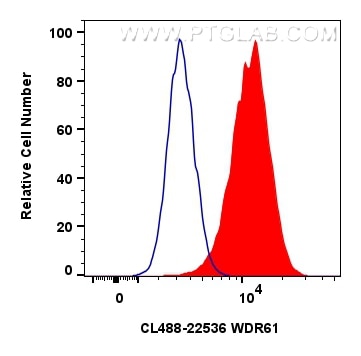Validation Data Gallery
Tested Applications
| Positive FC (Intra) detected in | HeLa cells |
Recommended dilution
| Application | Dilution |
|---|---|
| Flow Cytometry (FC) (INTRA) | FC (INTRA) : 0.80 ug per 10^6 cells in a 100 µl suspension |
| It is recommended that this reagent should be titrated in each testing system to obtain optimal results. | |
| Sample-dependent, Check data in validation data gallery. | |
Product Information
CL488-22536 targets WDR61 in FC (Intra) applications and shows reactivity with human, mouse, rat samples.
| Tested Reactivity | human, mouse, rat |
| Host / Isotype | Rabbit / IgG |
| Class | Polyclonal |
| Type | Antibody |
| Immunogen |
CatNo: Ag18443 Product name: Recombinant human WDR61 protein Source: e coli.-derived, PET28a Tag: 6*His Domain: 1-305 aa of BC010080 Sequence: MTNQYGILFKQEQAHDDAIWSVAWGTNKKENSETVVTGSLDDLVKVWKWRDERLDLQWSLEGHQLGVVSVDISHTLPIAASSSLDAHIRLWDLENGKQIKSIDAGPVDAWTLAFSPDSQYLATGTHVGKVNIFGVESGKKEYSLDTRGKFILSIAYSPDGKYLASGAIDGIINIFDIATGKLLHTLEGHAMPIRSLTFSPDSQLLVTASDDGYIKIYDVQHANLAGTLSGHASWVLNVAFCPDDTHFVSSSSDKSVKVWDVGTRTCVHTFFDHQDQVWGVKYNGNGSKIVSVGDDQEIHIYDCPI 相同性解析による交差性が予測される生物種 |
| Full Name | WD repeat domain 61 |
| Calculated molecular weight | 305 aa, 34 kDa |
| Observed molecular weight | 33 kDa |
| GenBank accession number | BC010080 |
| Gene Symbol | WDR61 |
| Gene ID (NCBI) | 80349 |
| RRID | AB_3672744 |
| Conjugate | CoraLite® Plus 488 Fluorescent Dye |
| Excitation/Emission maxima wavelengths | 493 nm / 522 nm |
| Form | |
| Form | Liquid |
| Purification Method | Antigen affinity purification |
| UNIPROT ID | Q9GZS3 |
| Storage Buffer | PBS with 50% glycerol, 0.05% Proclin300, 0.5% BSA{{ptg:BufferTemp}}7.3 |
| Storage Conditions | Store at -20°C. Avoid exposure to light. Stable for one year after shipment. Aliquoting is unnecessary for -20oC storage. |
Background Information
Component of the PAF1 complex (PAF1C) which has multiple functions during transcription by RNA polymerase II and is implicated in regulation of development and maintenance of embryonic stem cell pluripotency (refer to UniProt). Catalog#22536-1-AP is a rabbit polyclonal antibody raised against the full-length of human WDR61. The MW of this protein is 33 kDa, and this antibody specially recognises the 33 kDa protein.
Protocols
| Product Specific Protocols | |
|---|---|
| FC protocol for CL Plus 488 WDR61 antibody CL488-22536 | Download protocol |
| Standard Protocols | |
|---|---|
| Click here to view our Standard Protocols |

